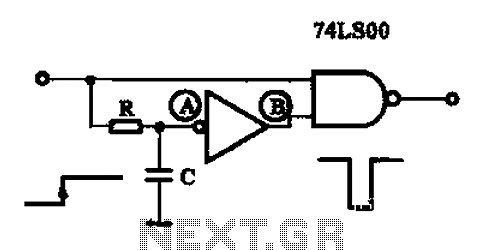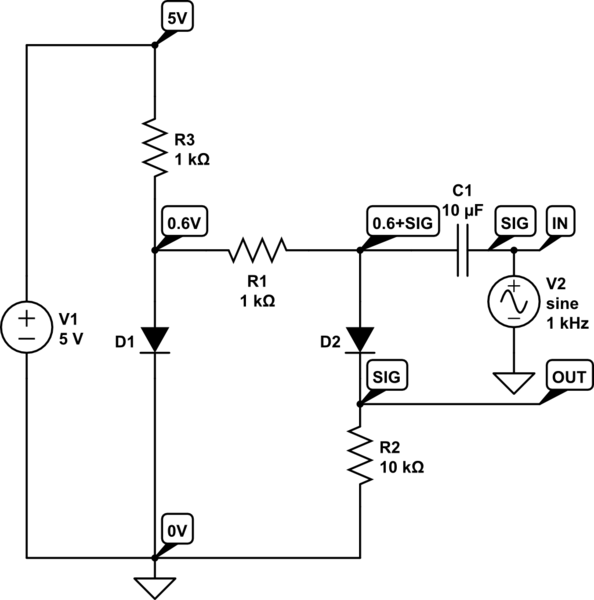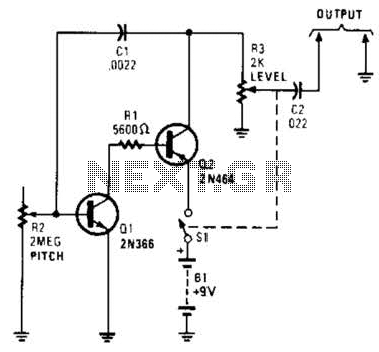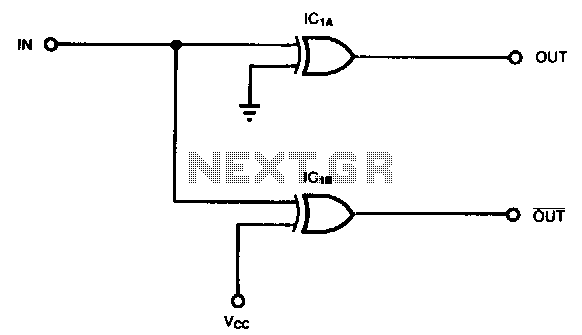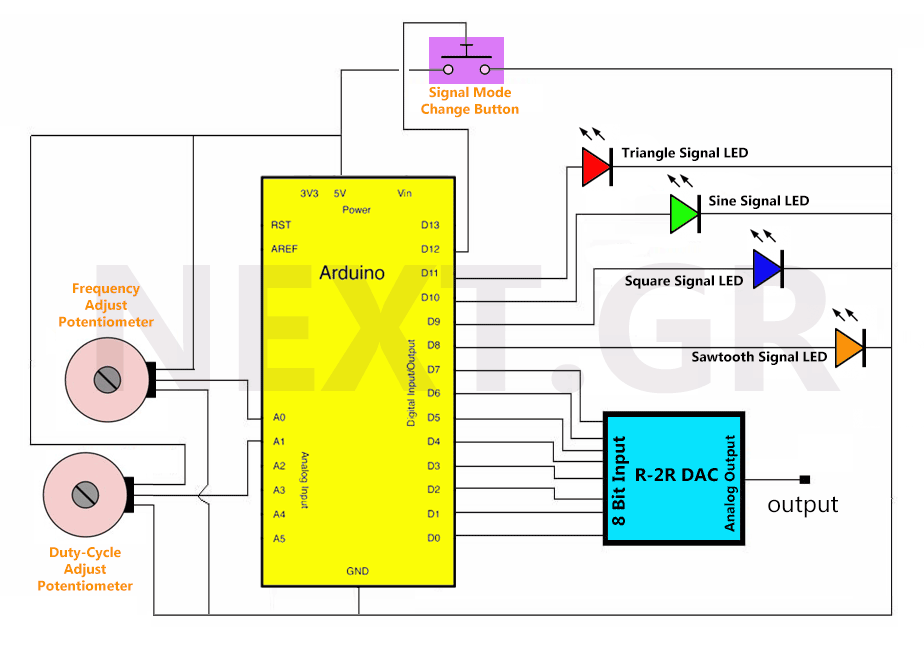
Sine Signal Generating
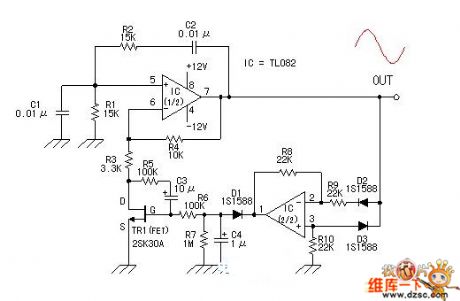
The circuit is capable of changing the frequency range, with the oscillating signal adjustable via potentiometer RP1. The output resistance is low (1 kΩ), making it suitable for various control circuit applications as a signal source. In this design, the transistor's collector passes through resistors R1, R2, and capacitors C1, C2 to the base, forming a feedback loop. The parameters of the device can be modified. The Burr-Brown 4302 multifunction converter utilizes an operational amplifier to generate a hyperbolic sine transfer function, achieving a response that closely matches the ideal curve within 0.7%. This technique allows for setting powers and roots at both fractional and integer values. The converter is configured for an exponent of 3.2, with the choice of amplifier gain and reference voltage scaling the response for the specified input and output signal levels. Design equations are provided in the referenced article. The operational amplifier functions as a tuned circuit driven by a square wave from a voltage comparator, with frequency controlled by resistors R1-R3 and capacitors C1 and C2, where R3 provides tuning. The comparator receives the resulting sine wave to produce a square wave, which is fed back to the input of the tuned circuit to initiate oscillation. A Zener diode stabilizes the amplitude of the square wave feedback. Resistor R6 and capacitor C5 provide DC negative feedback around the comparator to ensure startup. The values of C1 and C2 are equal, ranging from 0.4 µF for 18-80 Hz to 0.002 µF for 4.4-20 kHz. The circuit utilizes the National SK0003 sine/cosine look-up table kit, which consists of four MOS ROMs and three output adders, to implement the equation sin = sin M cos L + cos M sin L. The worst-case error is 1 5/8 bits in the least significant bit, with cosine approximated at a resolution loss of 1/2 bit for 11-bit input or 1/4 bit for 10-bit input. The combination of SN72310 voltage-follower operational amplifier and SN72301A high-performance operational amplifier produces two outputs that differ in phase by 90 degrees, powered by a ±18 V supply. The circuit also employs an NE571 analog compandor in an oscillator circuit based on a Wien network formed by R1-C1 and R2-C2, which is placed around the output amplifier of section A to create a bandpass amplifier. Section B functions as an inverting amplifier with a nominal gain of 2, maintaining total harmonic distortion below 0.1%. The operating frequency is approximately 1.6 kHz for the specified values but can be adjusted from 10 Hz to 10 kHz. The frequency can be calculated as 1/2πRC for R = R1 = R2 and C = C1 = C2, with resistors kept between 10 kΩ and 1 MΩ and capacitors between 1000 pF and 1 µF. This configuration is useful as a fixed-frequency oscillator but can be tuned using matched dual potentiometers for R1 and R2. A square wave oscillator utilizing Q2 and Q3 is stabilized by Q1, followed by a passive filter and an active filter using an A709 operational amplifier, producing an amplitude-stabilized sine wave at 350 Hz, with the third harmonic down by 39 dB and other harmonics being negligible. The output voltage is 8 V peak-to-peak at approximately 25 Hz for the specified values, with total harmonic distortion below 0.5%. The circuit can operate from 15 Hz to 100 kHz with appropriate component values. The regeneration control R1 should be set to the minimum value required to maintain oscillation. A peak detector is employed with a FET operating in voltage-variable resistance mode, in conjunction with a standard double-integration circuit featuring regenerative feedback to yield a 1.46 kHz sine wave output into a 500-ohm load at 10 V peak-to-peak. This circuit operates with power supply voltages ranging from 8 to 18 V without significant variation in output amplitude or frequency, with output variations of less than 1.5% in frequency and 6% in amplitude.It can change the frequency range, and the oscillating signal is adjusted by potentiometer RP1. Since the output resistance is very low ( 1K ©), it issuitable for various kinds of control circuit as a source. In the circuit, the transistor`s collector passesthrough R1, R2, C1, C2 to base to constitute feedback branch.
Changing the device`s parameters is OK. (View) Burr-Brown 4302 multifunction converter and opamp generate hyperbolic sine transfer function with response matching ideal curve within 0. 7%. Technique permits setting powers and roots at fractional as well as integer values. Converter shown is set for exponent of 3. 2. Choice of amplifier gain and ref erence voltage scales response for given input and output signal levels. Article gives design equations. -J. Graeme, Sinh Generator Boasts 0. 7% Error, END Magazine, Aug. 5, 1978, p 70 and 72. (View) Opamp is used as tuned circuit driven by square wave from yoltage comparator Frequeny is controlled by R1-R3, C1, and C2, with R3 providing tuning.
Comparator is fed with resulting sine wave to obtain square wave for feedback to input of tuned circuit, to cause oscillation. Zener stabifizes amplitude of square wave that is fed back. R6 and C5 provide DC negative feedback around com arator to ensure starting. Values of C1 and C2 are equal, and range from 0. 4 F for 18 80Hz to 0. 002 F for 4. 4-20 kHz. ``Easily Tuned Sine Wave Oscillator, ³National Semiconducotor, Santa Clara, CA, 1971, LB-16. (View) Uses National SK0003 sine/cosine look-up table kit consisting of four MOS ROMs and three output adders.
Combination implements equation sin =sin M cos L + cos M sin L. Worst-case error is 1 5/8 bits in least significant bit. Cosine is approximated with loss in resolution of1/2 bit in 11-bit input or1/4 bit in 10-bit input. - Memory Databook, National Semiconductor, Santa Clara, CA, 1977, p 6-98-6-99. (View) Combination of SN72310 voltage-follower opamp and SN 72301A high-performance opamp gives two outputs differing in phase by 900. Supply is ±18 V. - The Linear and Interface Circuits Data Book for Design Engineers, Texas Instruments, Dallas, TX, 1973, p 4-40.
(View) Uses NE571 analog compandor in oscillator circuit based on Wien network formed by R1-C1 and R2-C2, placed around output amplifier of section A to make it bandpass amplifier. Section B serves as inverting amplifier with nominal gain of 2. Total harmonic distortion is below 0. 1%. Operating frequency is about 1. 6 kHz for values shown, but can be varied from 10 Hz to 10 kHz. Frequency is l/21 RCforR = R1 = R2 and C = Cl = C2. R should be kept between 10K and 1 megohm and C between 1000 pF and 1 F. Useful as fixed-frequency oscillator but can be tuned if matched dual pot is used for R1. R2. -W. G. Jung, Gain Control IC for Audio Signal Processing. Ham Radio, July 1977, p 47-S3. (View) Squarewave oscillator Q2-Q3 stabilized by Q1, followed by passive filter and active filter using A709, produces amplitude-stabilized sine wave at 350 Hz, for which third harmonic is 39 dB down and other harmonics are insignificant.
-E. Neugroschel and A. Paterson, Amplitude-Stabilized Audio Oscillator, EEE Magazine, April 1971, p 65. (View) Output voltage is 8 V P-P at about 25 Hz for values shown, with total harmonic distortion less than 0. 5%. Circuit will operate from 15 Hz to 100 kHz by using other values. Set regeneration control Rl, at minimum value needed to sustain oscillation. -J. C. Freebom, Simple Sinewave Oscillator, EDN/EEE Magazine, Sept. 1, 1971, p44. (View) Peak detector is used with FET operated in voltage variable. -resistance mode. in combination with standard double-integration circuit having regenerative feedback. to give 1. 46-kHz sinewave output into 500-ohm load at 10 V P-P. Will operate at power supply voltages off 8 to 18 V whhout appreciable variation in output amplitude or frequency.
Output varies less than 1. 5% in frequency and 6% in amplitude 🔗 External reference
Changing the device`s parameters is OK. (View) Burr-Brown 4302 multifunction converter and opamp generate hyperbolic sine transfer function with response matching ideal curve within 0. 7%. Technique permits setting powers and roots at fractional as well as integer values. Converter shown is set for exponent of 3. 2. Choice of amplifier gain and ref erence voltage scales response for given input and output signal levels. Article gives design equations. -J. Graeme, Sinh Generator Boasts 0. 7% Error, END Magazine, Aug. 5, 1978, p 70 and 72. (View) Opamp is used as tuned circuit driven by square wave from yoltage comparator Frequeny is controlled by R1-R3, C1, and C2, with R3 providing tuning.
Comparator is fed with resulting sine wave to obtain square wave for feedback to input of tuned circuit, to cause oscillation. Zener stabifizes amplitude of square wave that is fed back. R6 and C5 provide DC negative feedback around com arator to ensure starting. Values of C1 and C2 are equal, and range from 0. 4 F for 18 80Hz to 0. 002 F for 4. 4-20 kHz. ``Easily Tuned Sine Wave Oscillator, ³National Semiconducotor, Santa Clara, CA, 1971, LB-16. (View) Uses National SK0003 sine/cosine look-up table kit consisting of four MOS ROMs and three output adders.
Combination implements equation sin =sin M cos L + cos M sin L. Worst-case error is 1 5/8 bits in least significant bit. Cosine is approximated with loss in resolution of1/2 bit in 11-bit input or1/4 bit in 10-bit input. - Memory Databook, National Semiconductor, Santa Clara, CA, 1977, p 6-98-6-99. (View) Combination of SN72310 voltage-follower opamp and SN 72301A high-performance opamp gives two outputs differing in phase by 900. Supply is ±18 V. - The Linear and Interface Circuits Data Book for Design Engineers, Texas Instruments, Dallas, TX, 1973, p 4-40.
(View) Uses NE571 analog compandor in oscillator circuit based on Wien network formed by R1-C1 and R2-C2, placed around output amplifier of section A to make it bandpass amplifier. Section B serves as inverting amplifier with nominal gain of 2. Total harmonic distortion is below 0. 1%. Operating frequency is about 1. 6 kHz for values shown, but can be varied from 10 Hz to 10 kHz. Frequency is l/21 RCforR = R1 = R2 and C = Cl = C2. R should be kept between 10K and 1 megohm and C between 1000 pF and 1 F. Useful as fixed-frequency oscillator but can be tuned if matched dual pot is used for R1. R2. -W. G. Jung, Gain Control IC for Audio Signal Processing. Ham Radio, July 1977, p 47-S3. (View) Squarewave oscillator Q2-Q3 stabilized by Q1, followed by passive filter and active filter using A709, produces amplitude-stabilized sine wave at 350 Hz, for which third harmonic is 39 dB down and other harmonics are insignificant.
-E. Neugroschel and A. Paterson, Amplitude-Stabilized Audio Oscillator, EEE Magazine, April 1971, p 65. (View) Output voltage is 8 V P-P at about 25 Hz for values shown, with total harmonic distortion less than 0. 5%. Circuit will operate from 15 Hz to 100 kHz by using other values. Set regeneration control Rl, at minimum value needed to sustain oscillation. -J. C. Freebom, Simple Sinewave Oscillator, EDN/EEE Magazine, Sept. 1, 1971, p44. (View) Peak detector is used with FET operated in voltage variable. -resistance mode. in combination with standard double-integration circuit having regenerative feedback. to give 1. 46-kHz sinewave output into 500-ohm load at 10 V P-P. Will operate at power supply voltages off 8 to 18 V whhout appreciable variation in output amplitude or frequency.
Output varies less than 1. 5% in frequency and 6% in amplitude 🔗 External reference
